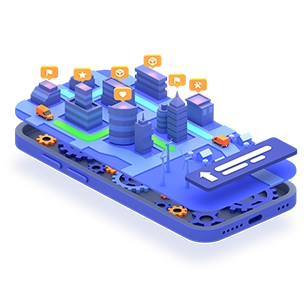Table of Contents
Have you decided to go for route optimization software?
Well… congratulations; you’re on the right track. You no longer need to worry about route planning, driver management, and customer satisfaction.
But, should you build the software in-house or buy commercial off-the-shelf software (COTS)?
If you’ve got this question in your mind, then you’re not alone. This common question routinely crops up among many business owners when it comes to implementing routing optimization software.
Honestly speaking, it may seem simple, but determining the right approach is a complex process. In the past, building software frequently won out in this debate.
But, with the introduction of cloud computing, the tables have turned. Cloud-based delivery scheduling software is entirely plug-and-play and you don’t need to install any application.
ALSO READ: 7 Reasons You Should Adopt a SaaS Route Planning Software
Also, it comes with native high availability, elastic scalability, and multiple low-latency edge points-of-presence for ultra-low latency route optimization. And, all these benefits come at half or one-third of the cost of custom-built software.
So, does that mean you should go for canned software?
The answer is that it depends on your requirement. You need to first assess your needs based on several other parameters and questions to ensure that you make the correct decision. And this is what we are going to help you within this article.
We will discuss the technical and business aspects of both options so that you can make an informed decision. So, let’s take a look at these aspects.
#1 Do You Have the Right Team to Build Route Optimization Software?
Building software requires relevant skilled resources. So, you first need to identify whether you have the right resources in-house already to match up all the skills and experience required to develop a route optimization software.
To build a route optimization and operational optimization system, you need experts in advanced mathematical and geometric disciplines. Developing such expertise takes at least eight years of postgraduate (Ph.D.) college coursework.
In addition to such experts, your IT department should also know how to build systems that can:
- Handle millions of transactions;
- Analyze the transactions;
- Back up the transactions;
- Share the transactions with partners;
- Connect the data to other systems; and
- Set up audit and compliance.
Also, they should be able to build APIs that can plan, manage, and execute millions of deliveries every year.
Do you have such resources available?
If not, you should definitely buy such software and not build one.
Want To See For Yourself How Route4Me Can Boost Your Profits?

#2 Does Your Team Have the Required Skills to Develop the Software?
Assuming your IT department can do all the things mentioned above, there are still many other complex tasks that need to be done to develop a foolproof route planner.
For example, the entire system still needs to be programmed which involves:
- Creating geospatial databases;
- Geocoding;
- Generating maps;
- Importing and processing maps;
- Changing arrival times with real-time traffic conditions; and
- Creating all the mobile apps to work on iPhones, iPads, Android phones, and Android tablets.
Your IT team will also need to connect all your mobile apps with your servers in a data center or on the cloud.
Moreover, they need to make sure that the GPS tracking works, that the app can work with or without the internet and that it will work in a massive number of scenarios that you may not even consider beforehand.
So, before going ahead with the development, you need to identify how many years of optimization and mobile programming your team has.
If they just install and manage your desktop computers and laptops, chances are that this sort of project is not possible.
This is especially true considering that even experienced programmers require millions of dollars per year to build a route optimization platform like Route4Me from the ground up.
#3 What Is the Total Cost of Ownership and Can You Afford It?
No matter what decision you make, you need to ensure it is financially viable for you. So, you need to carefully evaluate the total cost of ownership of a vehicle route planning software.
If you plan to build the software, you need to look at the features offered by vendors and assess whether you can develop a similar app for cheaper internally.
But, buying should be a good option if the vendor:
- Offers more benefits and features than you anticipated or the same set of capabilities at a reduced cost; and
- Has a long list of successful customers.
Also, developing route optimization software yourself means dealing with continuous internal trade-offs.
So, you should ask yourself whether you’re dedicated enough to invest the amount that is required over the years with the in-house option or whether you should rather make an upfront investment by purchasing such software.
Part of this equation also relates to scalability. Your business will grow over the years so you need to build the software in such a way that no matter how the number of drivers or areas that you need to manage increases over time, you won’t face a single glitch in the near future.
So, you also need to ask yourself whether you can continue shelling out money to scale up your own software as your business grows or whether you want to use software that is already able to scale up due to the provider’s continuous investment.
A delivery route planner provider deals with multiple customers. For example, Route4Me’s mobile Android and iPhone apps have been downloaded over 2 million times since 2009.
Multi-Stop Route Planner App

The app is also being used to make over 100,000,000 visits per year. And, like us, many software providers learn from each of their customers based on their unique needs and requirements.
So, buying a route planner app instead of building one will ensure that you have an insurance policy to make sure that your needs will constantly be invested in.
#4 How Soon Will You Be Able to Use the Route Optimization Software?
You cannot keep developing software for years and years.
The development process should have a deadline for each activity, including the time needed to design, architect, build, and test the solution. All these steps should be done carefully and require a significant amount of time; if the steps are done incorrectly, it will result in poor output.
So, ask yourself whether you need rapid deployment or whether you can afford the time required to build the software yourself?
If you think your developers can build routing software within the deadline, then consider whether they really have developed any software within the time constraints before.
If they have made deadlines before, then look at the complexity of the previous projects.
A simple software will be easy to develop, but route optimization software requires complex algorithms, which are difficult to develop, and demand a lot of time.
So, they might often miss the deadline. If they failed to develop any software within the deadline before, then they are certainly not the right fit to develop routing optimization software.
You will also agree that working in your industry means that software development might not be your area of expertise. Yet, even organizations with the best intentions run into delays if they embark on building an app that is outside their area of expertise.
So, if you want to develop the software yourself, you must earnestly consider the impact of the other demands placed on your IT department. Due to such demands, your IT team might miss a deadline for a new project and you need to understand how much such delays will cost your business.
Also, there are already planning and routing software available and most of these are cloud-based which helps you get started in no time with almost no effort. So, you will experience no deadline hassles or time constraints with canned software.
However, if you think that your developers won’t miss deadlines and you can afford the time and money to put together a team of a few dozen people to work several million man-hours, then you should build the software yourself.
#5 How Much Will the Support for the Software Cost?
While making a build-versus-buy decision, you also need to analyze the short- and long-term support costs for the software.
Support is crucial for the ongoing provision of any software implementation because it directly influences user adoption. It can cost your company quite a bit of money as it is ongoing, even after the software has already been developed.
Therefore, whether it is part of your IT department or you have a distinct support organization, it is critically important to include the short- and long-term projections for support costs.
You should also consider what the costs would be for:
- Support for new employees;
- Feature upgrades; and
- Regional support staff.
Building a custom vehicle route planning software may demand a lot of investment in building a strong support system, but that’s not the case when you buy such software.
For example, Route4Me route planner offers web and mobile platforms that integrate with multiple monitoring, crash tracking systems, app performance management systems, and a 24/7 support team to maintain a carrier-grade QoS level.
Therefore, we carry the costs and you don’t need to invest a single penny for support which could save you a lot of money. You also don’t need to pay for hiring, retention, infrastructure, training, and other costs.
#6 What is the Impact of Feature Deficits?
You must remember that if you choose to build routing optimization software internally, there will always be a feature deficit in its delivery.
This happens primarily due to the shifting timelines and changing priorities.
But, when you buy cloud-based route scheduling software, you will get the most comprehensive and up-to-date set of capabilities.
And, you will get all this with zero or little lag in terms of how long your organization has to wait to onboard the features. So, choose your option wisely.
Conclusion about Route Optimization Software
Both building software internally and buying commercial off-the-shelf software come with their own pros and cons.
For example, when you build software, you have total control over the development and features. The software is also specific to your unique needs and you own the software code.
But, it requires a significant time investment to configure or write the code, integrates the software with other systems, and adapt to the user requirements after deployment.
Also, building the software offers lower functionality than software vendors’ apps.
So, if you have a tight budget, cannot wait for a long period, and don’t have the right skilled resources or don’t know how to get the required resources, then developing software internally is certainly not recommended.
This is especially true since there is software available for purchase when you need them. The route optimization software vendors have already invested thousands of hours in researching, developing, and creating the product and so the software comes with fewer bugs. Also, such software offers greater adaptability and flexibility.
Furthermore, when buying fleet route planning software, you can be sure that the app’s functionality will be improved continuously due to customer suggestions and the anticipation of your changing business requirements.
However, with canned software, you have to depend on the vendor’s support to resolve issues and the developer retains the right to the code.
But, this should not be a concern to you if the software provider is available for support immediately and doesn’t take much time to resolve any issues.
After all, it’s still better than spending countless hours in setting up, developing, and maintaining software as well as hiring the workforce to execute it in the right way. And, don’t forget the hefty expenses either.
So, what decision have you made? Will you build or buy route optimization software? Let us know in the comments section below.
Want To See For Yourself How Route4Me Can Boost Your Profits?










